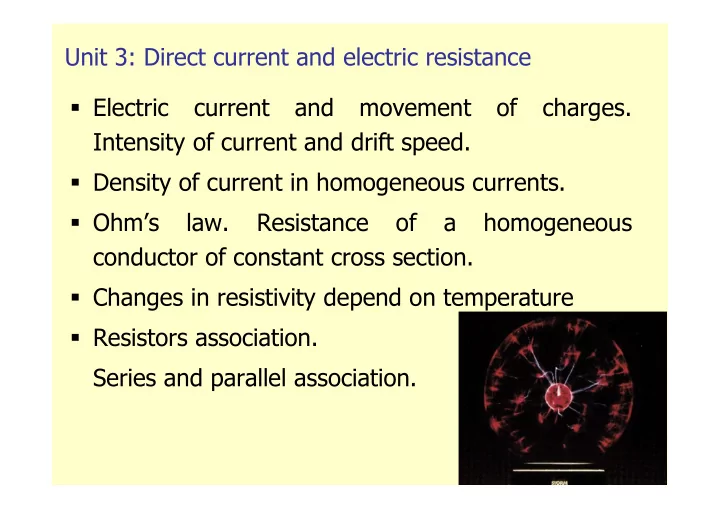

Unit 3: Direct current and electric resistance Electric current and movement of charges. Intensity of current and drift speed. Density of current in homogeneous currents. Ohm’s law. Resistance of a homogeneous conductor of constant cross section. Changes in resistivity depend on temperature Resistors association. Series and parallel association.
Electric current and movement of charges An electric current occurs when a conductor is not in electrostatic equilibrium. This can be achieved by applying an electric field ≠ 0 to the conductor. + + ∆ q E I = + + ∆ t Intensity is a base quantity. Unit: Ampère I is the same for any cross section of the conductor Although the moving particles in a conductor are electrons, for historical reasons electric current is studied as positive charges moving in the direction of the electric field. Tipler, chapter 25, part 25.1
Electric current and movement of charges The charges collide with the nuclei of the atoms, V d causing chaotic movement. These collisions set up a resistance to the movement of the charges (electric resistance). An average speed (drift speed V d ) can be v d computed for the charges, V d being related µ = E to E. This rate is called mobility ( µ ): Drift speed is the modulus of vector drift velocity
Electric current and movement of charges A characteristic of each conductor is the number of free electrons per unit of volume (n) (density of charge carriers), which depends on the chemical structure of the material. Our hipothesys is that all the electrons are moving at once (like a log) inside the conductor. Obviously, I and V d are related through n: V d t: distance covered by an electron during Δ t AV d t: volume crossing A during Δ t nqAV d t: charge crossing A during Δ t A: cross section of conductor ∆ q n q A v ∆ t d I = = = n q A v d ∆ t ∆ t
Density of electric current in homogeneous conductors. Current density (J) is the intensity of current through a cross section of the conductor, divided into the section. This rate can be computed at any point of the cross section: I I nqAv [J]=IL -2 d J nqv = = = d A A
Ohm’s Law � � E is a vector with the same direction as at any J point: � � J E Omh’s Law = σ � J E σ conductivity ≅ ( Ω m) -1 ρ =1/ σ resistivity ≅ Ω m Ω -1 = S (Siemens) Materials obeying Ohm’s law are called ohmic materials. Tipler, chapter 25, part 25.2
Electric Resistance of a homogeneous conductor of constant cross section. � b b b � J I I I L b b ρ V V E d r Edr dr dr dr − = = = = = = a b A A A σ σ σ a a a a a V V L − ρ a b R R = = = I A [R]=ML 2 T -1 Q -2 R is called electrical resistance of E is always pointing to conductor, depending on its lower potentials (V a >V b ) material, shape and size. Is measured in Ohms Tipler, chapter 25, part 25.2
Changes in resistivity depending on temperature The resistance of conductors increases with temperature due to the higher number of collisions between free electrons and nuclei. [ ] ( T º C ρ = ρ 1 + α − 20 20 Tipler, chapter 25, section 25.2
Combinations of resistors. Resistors in series. V V IR IR I R ( R ) − = + = + a c 1 2 1 2 R R R = + eq 1 2 V V IR − = a c eq n R = R eq i i = 1 Tipler, chapter 25, section 25.4
Combinations of resistors. Resistors in parallel. V V V V 1 1 − − a b a b I I I ( V V )( ) = + = + = − + 1 2 a b R R R R 1 2 1 2 1 1 1 = + R R R eq 1 2 V V − a b I = R eq n 1 1 = R R i = 1 eq i
Recommend
More recommend